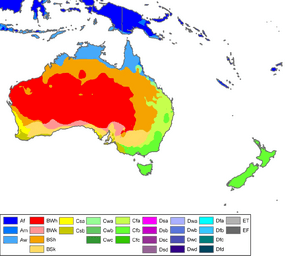Köppen climate classification facts for kids
The Köppen climate classification is a popular way to group different climates around the world. A German scientist named Wladimir Köppen created it around 1900. He made some changes to it later, in 1918 and 1936.
This system looks at the natural vegetation (plants) in an area. Köppen believed that plants show what the climate is like. So, the boundaries for each climate zone are chosen based on where different plants grow.
Contents
Understanding the Köppen Climate System
The Köppen system divides the world's climates into five main groups. These groups are based on temperature and how much rain or snow an area gets. Each group has specific rules for its climate.
Group A: Tropical Climates
- Group A climates are tropical. These places are warm all year round.
- Even in the coolest month, the average temperature must be at least 18°C (64.4°F).
- You'll find these climates near the equator. They often have lots of rain.
Group B: Dry Climates
- Group B climates are arid, meaning they are very dry.
- This group includes deserts and steppes (also called semi-arid areas).
- These places get very little rain or snow. The amount of rain needed to be considered dry depends on the temperature.
Group C: Temperate Climates
- Group C climates are also called mesothermal or temperate. They have warm summers and mild winters.
- The average temperature in the warmest months must be above 10°C (50°F).
- The coldest month's average temperature must be between 0°C (32°F) or -3°C (26.6°F) and 18°C (64.4°F).
- This group includes humid subtropical, Mediterranean, and oceanic climates.
Group D: Continental Climates
- Group D climates are microthermal or continental. They have hot or warm summers and cold, snowy winters.
- The warmest months must have an average temperature above 10°C (50°F).
- The coldest months must have an average temperature below 0°C (32°F) or -3°C (26.6°F).
- This group also includes subarctic climates, which have short, warm summers and very cold winters.
Group E: Polar and Alpine Climates
- Group E climates are polar and alpine. These are very cold places.
- Even in the warmest month, the average temperature must be less than 10°C (50°F).
- You'll find these climates at the Earth's poles or on very high mountains.
Group H: Highland Climates
- Group H climates are found in highland areas.
- These climates change a lot based on how high up you are.
- Temperatures get colder as you go higher, similar to polar climates, even if they are near the equator.
Related pages
Images for kids
-
The snowy city of Sapporo
See also
 In Spanish: Clasificación climática de Köppen para niños
In Spanish: Clasificación climática de Köppen para niños

All content from Kiddle encyclopedia articles (including the article images and facts) can be freely used under Attribution-ShareAlike license, unless stated otherwise. Cite this article:
Köppen climate classification Facts for Kids. Kiddle Encyclopedia.



